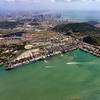Less Diesel Exhaust at Port of Los Angeles
New data from four state-of-the-art air quality monitoring stations in and around the Port of Los Angeles show concentrations of elemental carbon in the Port area air fell in 2009 for the third straight year. Elemental carbon is used as an indicator of diesel particulate matter, or DPM, which is the soot produced by the combustion of diesel fuel. DPM has been designated a toxic air contaminant and known carcinogen by State of California health officials.
The results are proof-positive that air quality in the L.A. Harbor is improving as a result of substantial investments the Port, its tenants and other Port-related businesses have made in recent years by purchasing cleaner equipment and participating in a variety of emission-reduction initiatives. New State air quality regulations also have helped slash emissions from the big diesel engines that power the movement of cargo at the Port.
The result has been a major drop in concentrations of diesel exhaust in Port-area communities: in 2009, DPM, measured as elemental carbon, was 34 percent lower in San Pedro and 45 percent lower in Wilmington than in 2006.
“When we adopted the Clean Air Action Plan in 2006, the Port of Los Angeles made a commitment to its communities to do everything it could to improve air quality and protect the Port workforce and nearby residents from harmful effects of port operations,” said Port Executive Director Geraldine Knatz, Ph.D. “I’m very pleased to see that the latest results from air quality monitoring stations show that we are living up to that commitment.”
Concentrations of another key air pollutant, PM2.5 (particles less than 2.5 microns in size) met Federal and State standards in both 2008 and 2009, the first time that has occurred since monitoring began in the Port area.
Since 2005 the Port has operated four air quality measurement stations: one in San Pedro, another in Wilmington, and two inside the Port complex, including one in the middle of the active cargo handling area. The stations are located so as to measure air quality both in the Port complex and in the communities downwind of the Port, where air quality is affected by emissions from the ships, trucks, terminal equipment, harbor vessels and train locomotives that move cargo through the nation’s largest container port.
The data from 2009 shows that elemental carbon concentrations in the air at the “source-dominated station,” which is the station in the midst of the cargo terminals, has fallen by 48 percent since 2006. Concentrations at the San Pedro and Wilmington stations have fallen by 34 percent and 45 percent, respectively. The decline is smaller at the community stations than at the in-port station because port sources make up a smaller fraction of the total emissions at those stations, so that declines in port sources have less effect.
“This dramatic decline in the amount of DPM and the fact that we have attained air quality standards for PM2.5 show that the measures we adopted in the Clean Air Action Plan are really working to reduce harmful air pollutants in neighboring communities,” said Christopher Patton, the Environmental Affairs Officer who heads the Port’s air quality staff.
Truck emissions, a perennial source of DPM in Port-area air, have been substantially reduced by the Port’s Clean Truck Program. Since the Clean Truck Program launched on October 1, 2008, the Port has distributed more than $70 million to spur the purchase of more than 2,700 cleaner, newer trucks. There are currently more than 6,500 trucks serving the San Pedro Bay port complex that meet or exceed the U.S. EPA 2007 heavy-duty truck emissions standards.
Patton also cited the State’s restrictions on the sulfur content of fuel used in vessels and equipment operated at the port, the Port’s Alternative Maritime Power program, and the San Pedro Bay Vessel Speed Reduction program as key measures the State and the Port have used to tackle vessel emissions. The Port has also spent millions of dollars retrofitting cargo handling equipment and harbor craft engines with pollution control devices, and pioneering the use of alternative fuels and power systems. The air quality monitoring stations measure, in real time, ambient concentrations of several key air pollutants, including two sizes of particulate matter (PM10 or coarse particles, and PM2.5 or fine particles). In addition, twenty-four hour integrated samples of particulates are collected on filters every third day for detailed chemical analyses, which cannot be done with real-time monitors. Those analyses include measuring the amount of elemental carbon in the filters.
Each station also collects wind speed, wind direction, and temperature data so that the air pollutant data can be used in models that track the movement of pollutants. The real-time data can be viewed at caap.airsis.com and past data back to 2005 can be viewed on the Port’s website (www.portoflosangeles.org/environment/air_quality.asp).
DPM has been designated a toxic air contaminant and known carcinogen by the State of California health officials. The Clean Air Action Plan’s goal is to cut Port-related air emissions by 45 percent by the year 2011. The latest monitoring results suggest that the Port is making significant progress towards that goal.














